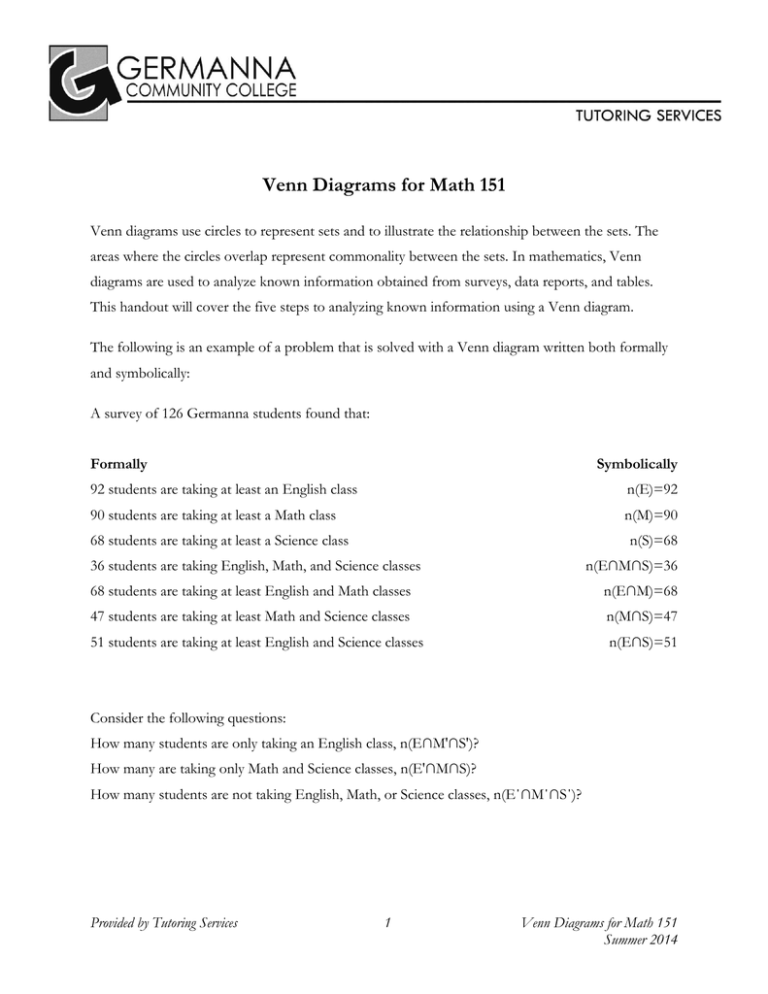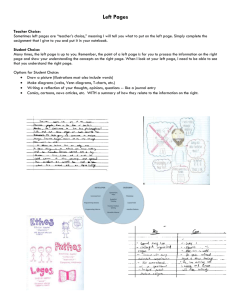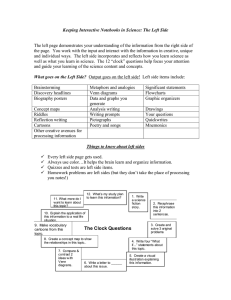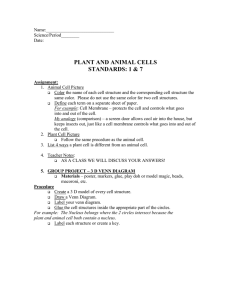Venn Diagrams for Math 151
advertisement

Venn Diagrams for Math 151 Venn diagrams use circles to represent sets and to illustrate the relationship between the sets. The areas where the circles overlap represent commonality between the sets. In mathematics, Venn diagrams are used to analyze known information obtained from surveys, data reports, and tables. This handout will cover the five steps to analyzing known information using a Venn diagram. The following is an example of a problem that is solved with a Venn diagram written both formally and symbolically: A survey of 126 Germanna students found that: Formally Symbolically 92 students are taking at least an English class n(E)=92 90 students are taking at least a Math class n(M)=90 68 students are taking at least a Science class n(S)=68 36 students are taking English, Math, and Science classes n(E∩M∩S)=36 68 students are taking at least English and Math classes n(E∩M)=68 47 students are taking at least Math and Science classes n(M∩S)=47 51 students are taking at least English and Science classes n(E∩S)=51 Consider the following questions: How many students are only taking an English class, n(E∩M'∩S')? How many are taking only Math and Science classes, n(E'∩M∩S)? How many students are not taking English, Math, or Science classes, n(E΄∩M΄∩S΄)? Provided by Tutoring Services 1 Venn Diagrams for Math 151 Summer 2014 Step 1 E Draw a Venn diagram with three circles. One circle represents English classes, M n(E); one represents Math classes, n(M); one represents Science classes, n(S). Additionally, draw a square around the three circles. This square represents the “universe,” n(U), or all students that are taking classes at Germanna; S U however, the circles only represent English, Math, and Science classes, as shown in Diagram A. The area outside of the circles is symbolically written Diagram A as n(U∩E'∩M'∩S') to represent the students taking classes other than English, Math, and Science. Step 2 When using Venn diagrams to analyze information, begin with the E M information shared by all three subjects. In the example, 36 students are 36 taking English, Math, and Science classes, n(E∩M∩S), so write “36” in the common area that represents English, Math, and Science, as shown in Diagram B. S U Diagram B Diagram B Step 3 After establishing the commonality between all three subjects, find the overlap between two subjects. In the example, a total of 68 students are taking English and Math classes, n(E∩M); and 36 of those students have already been counted as students who are taking English, Math, and Science classes. Therefore, the number of students who are only taking English and Math classes equals 68 minus 36, which equals 32. So, write “32” where the English and Math circles overlap, as shown in Diagram C. The equation is written as follows: 68 − 36 = 32 Provided by Tutoring Services 2 Venn Diagrams for Math 151 Summer 2014 Follow the same process for students who are taking just Math and Science classes, n(E΄∩M∩S), as well as just English and Science classes, n(E∩S∩M΄ ), as shown in Diagrams D and E. The equations for each are written as follows: Students taking Math and Science classes: 47 − 36 = 11 Students taking English and Science classes: 51 − 36 = 15 E 32 M E 36 M 32 E 36 36 11 U S U Diagram C M 32 S Diagram D 15 U 11 S Diagram E Step 4 The next step is to determine how many students are taking only an English class, n(E∩M'∩S'); only a Math class, n(M∩E'∩S'); or only a Science class, n(S∩M'∩E'). Recall that in the initial problem 92 students are at least taking an English class. However, 32 of the students are taking both English and Math classes; 15 are taking both English and Science classes, and 36 are taking English, Math, and Science classes. Therefore, of the 92 students taking at least an English class, it has been determined that 83 are taking another class while taking an English class. In order to find the total number of students taking only an English class, it is necessary to subtract 83 from 92, which equals 9, as shown in Diagram F. The following statement is the complete equation: 92 − (32 + 15 + 36) = 92 − 83 = 9 Provided by Tutoring Services 3 Venn Diagrams for Math 151 Summer 2014 Follow the same process to find how many students are taking only a Math class as well as to determine the number of students taking only a Science class, as shown in Diagrams G and H. The equations are as follows: Students taking only a Math class: 90 − (32 + 36 + 11) = 90 − 79 = 11 Students taking only a Science class: 68 − (15 + 36 + 11) = 68 − 62 = 6 E M 32 9 E 36 15 11 E 11 15 U Diagram F M 32 9 11 36 36 S U M 32 9 S Diagram G 11 15 11 U 6 S Diagram H Step 5 The final step is to determine how many of the 126 students surveyed are not taking an English, Math, or Science class, n(E΄∩M΄∩S΄). This number is written in the “universe,” not inside the circles. To calculate the amount of students who are not taking an English, Math, or Science class, add all of the numbers contained within the Venn diagram. For this example, the equation is: 36 + 32 + 11 + 15 + 11 + 6 + 9 = 120 Provided by Tutoring Services 4 Venn Diagrams for Math 151 Summer 2014 Out of a total of 126 students, 120 of the students are taking classes in English, Math, or Science. In order to determine the number of E students who are not taking these classes, subtract 120 from 126, 11 36 which equals 6. Write “6” in the area designated for the “universe”, as 15 shown in Diagram I. The following statement is the complete 6 equation: M 32 9 U 11 6 S Diagram I 126 − 120 = 6 Now, the questions can be answered: How many students are only taking an English class, n(E∩M'∩S')? 9 How many are taking only Math and Science classes, n(E'∩M∩S)? 11 How many students are not taking English, Math, or Science classes, n(E΄∩M΄∩S΄)? 6 Provided by Tutoring Services 5 Venn Diagrams for Math 151 Summer 2014 Practice Problems 1. A survey of 230 exotic pet owners shows that: 78 people own tarantulas 81 people own chinchillas 63 people own pot-belly pigs 46 people own chinchillas and tarantulas 62 people own exactly two of these exotic pets 31 people own tarantulas and pot-belly pigs 16 people own tarantulas, chinchillas, and pot-belly pigs Questions to solve: a. How many people do not own tarantulas, chinchillas, or pot-belly pigs? b. How many people own pot-belly pigs? c. How many people only own chinchillas? 2. A study of 200 books written since 2000 shows that there are three common character types: the villain, the female heroine, and the computer genius. 128 books have a villain or a female heroine 82 books have a female heroine 68 books do not have a female heroine, a villain, or a computer genius 54 books have a villain and a computer genius 28 books have all three character types 49 books have a female heroine and a computer genius 51 books have a villain and a female heroine Questions to solve: a. How many books include only a computer genius and a villain? b. How many books do not have a computer genius? c. How many books have a female heroine only? Provided by Tutoring Services 6 Venn Diagrams for Math 151 Summer 2014 3. A survey of 300 summer movie patrons found that most movie patrons viewed one of three types of movies: comedy, romance, and action. Let C= represent summer comedies R= represent summer romance movies A= represent summer action movies n(C)=156 n(R)= 106 n(A)=133 n(C∩R∩A)= 8 n(C∩R)=53 n(R∩A)=41 n(C∩A)=87 Questions to solve: a. How many summer movie goers did not see a comedy, romance, or action movie? b. How many summer movie goers saw a comedy or action movie? c. How many summer movie goers only saw a romance movie? 4. Draw an appropriate Venn diagram, and analyze the known information below. n(A∩B)=23, n(A∩B∩C)=9, n(A∩C)=28, n(B∩C)=11, n(A∩C΄)=22 n(B∩C΄)=27, n(A΄∩B΄∩C΄)=17, n(C)=37 Provided by Tutoring Services 7 Venn Diagrams for Math 151 Summer 2014 Solutions 1. a. 102, b. 63, c. 18 T 2. a. 26, b. 121, c. 10 F.H. C 30 18 17 C 4 U 3. a. 78, b. 202, c. 20 4. A R 45 24 20 78 U B 14 13 8 8 9 33 79 26 C.G. 68 P U 28 21 17 15 102 20 10 16 15 V 23 13 17 A Provided by Tutoring Services 2 19 U 81 7 C Venn Diagrams for Math 151 Summer 2014




